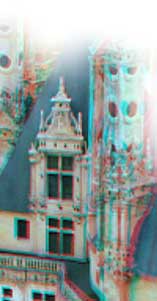 |
||
 |
Stereoscopic Direction
Monoscopic to Stereoscopic conversion
Ever since 1999 i've been doing R&D on Monoscopic to Stereoscopic conversion, dubbed 2D/3D. The purpose is to use the existing movies libraries and to convert them to stereoscopy and re-issue them, either in theaters or as stereoscopic DVD.
Why convert form 2D to 3D ?
To make a long story short, stereoscopy in the analog/chemical age was a pure nightmare of micrometric precision at every stage of the production and postproduction. The "Digital Revolution" brought us all the needed tools to make Stereoscopy easy as a pie. The latest step, the digitization of the theaters projectors, complete the evolution that allows movie makers tolls to be "Digital from lens to lens". That means from the camera lens to the projector lens, the pictures have been digits at every and each steps of the year long post/production process. That digital production make possible to bring you coherent and accurate stereoscopic images that are delighfull and confortable to watch. In a theater near you, sonner that you'll expect it.
Even if it's much easier and cheaper, it's a long process to make a stereoscopic movie. The purpose of the 2D/3D process is to bring all the existing blockbusters to a new life, releasing in a new stereoscpic version that have never been seen before, for it didn't even exists.
For instance, Geoges Lucas is having his Star Wars Trilogy converted into 3D.
How does it works ?
The conversion process consists in using original footage, used "main eye", and generate the "second eye" using specific CG softwares. For that process maintain the pristine original quality on your main eye, usualy the right, the resultant felling is that the overall picture is perfect. This is done using automatic content detection and multi-layering, based on motion vector analysis (I guess, for thoses folks won't tell you how it's done unless you handle them a few truckloads of ILM shares). Using background objects, you can compute the camera movement, focal and zoom.
Knowing that, you can compute for each "object", depending on it's relative movement to the camera, how far it is from the camera, That gives you a 3D map of the scene, also called z-map or depht-map. Using that map you can shift the pixels horizotaly to generate the second view. Another methods consists in generating a 3D object, texture it by projecting on it the original footage, and render the second eye using a virtual camera placed beside the virtual projector. Add tons of experienced hand-made fine-tunig, et voila !
[example, z-map, second eye, 3D object, texture projection, second eye]
You can have that system at home, in an extremly stiped-down quality, using DDD software or 3DTV harware. It's less that basic, but it gives you the unique opportunity to look at the evening news in 3D. That dwarves for sure your neighbours HDTV set !
2D/3D convertions at UCLA : Pulfrish
They were based on selecting 2D footages who were perfectly fitted to 2D/3D, using the pulfish effect. The principle is that any rotating object, or laterral panning footage, is its hown stereoscopic source. Making a time shift is just as making a viewer's position shift.
[After effects Screen Shoot : an example] [example and movies]
Do-it-yourself : The OpenGL spinning logo and a pair of sunglasses. [explain]
2D/3D convertions at UCLA : Projection mapping
For a lot of movies were brain views rendered using a standardized bain model, it was easy to make a projection-maping re-rendering.
Stereoscopic Production
Stereoscopy re-rendering
Some movies were still available as 3D scenes. I modified the camera setting to HDTV or to Dive resolution (anamorphic 3K) and rendered the movies using the stereoscopic module of Lightwave.
For that module does interfere with the render farm management software, and futhermore it didn't allow to animate the inter-pupillar space, I did actualy add a second camera on many movies
Stereoscopy modeling and rendering
To present the LONI's work horse, the Pipeline, I did direct the modeling, animation and rendering of the "pipeline metaphor" movie. I've done one third of the modeling / animation work. That movie, still under process shows the processing of a brain data across the steps of our pipeline.
[LW modeler and scene editor Screen Shots]
Stereoscopic compositing.
Using regular 2D compisitiong software, After Effects, I've drafted a movie for the Dive's inaugural party
[Screen shots, slideshow]
|
Bernard Mendiburu 6, rue Civiale, 75010 Paris, France |